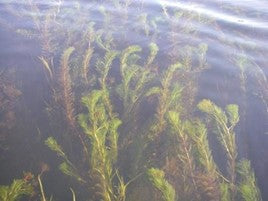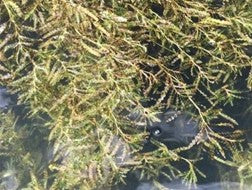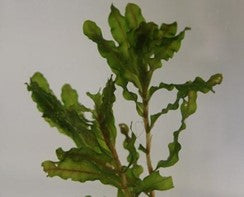No Products in the Basket
Unwanted Plantlife:
Aquatic invasive species are unfortunately prevalent across the landscape. I cover a few of the worst culprits (of the northern USA) here with more to follow in future posts. Plants become “invasive” not only due to their presence. They are invasive because they grow and spread rapidly, crowding out native beneficial plants. Here are a few ways to handle these problem organisms.
Perfunctory disclaimer:
Using pond chemicals safely is imperative. Please consult a pond and lake management firm before applying chemicals to your lake or pond. At the very least, please read and understand the labels of said chemicals well before applying them. There are many pond professionals out there who will gladly talk you through pond maintenance and weed and algae control. Please contact me at sales@midwestponds.com with questions about aquatic plant control.
Emergent Plants: (Cattails, Phragmites, Reed Canary Grass, Pond Lilies, other noxious shoreline weeds)




Allowing volunteer aquatic plants like narrow-leaf cattail to invade and proliferate is a great way to fill in your pond and attract other disreputable critters like muskrats. In small ponds (koi ponds, backyard watergardens), simply pulling out the offending plants is a viable control method. If they are allowed to infest the pond, pulling them all out becomes near impossible.
Most emergent noxious plants (like cattails and phragmites) can be cut off below the waterline to control their spread and eventually cull their numbers. This is a long process (sometimes eternally long) and requires multiple attempts to gain control. This is the easiest/least environmentally hostile option once tall emergent vegetation becomes a problem. This strategy does leave specimens that are fully above the waterline to deal with which is less likely to control the plant long term. Attempting this strategy almost always leads to the next step in control….
Faster, more effective options involve using aquatic herbicides. Aquatic herbicides will kill the plants before you cut them all down and carry them away or burn them in place. This option removes seeds and clears the area for replanting; it also allows you to easily see any survivors as they resprout. I recommend aquatic formulations of glyphosate (Shore Klear, Aquaneat, many others) for this task as they are very effective when used with an adjuvant/sticker (Cide Kick II, Turbulence, Duo Stick, many others) . The sticker agent allows the chemical to penetrate the waxy cuticle of the plants and travel to the root systems to kill off the entire organism. Other aquatic herbicides will work here, but glyphosate is widely available and is easy to use safely. Wear gloves and long sleeves when using glyphosate products. Be safe, folks.
The worst thing you can do is devoid your shoreline of all plants. Removing unwanted aquatic plants is fine, but eliminating one of the workhorses of your pond (the plants) is not recommended. We are not trying to create fishbowls…just a diverse shoreline plant community.
Submerged Aquatic Plants:
Unwelcome fully submerged aquatic plants (both native and invasive) are more difficult to fully control without the use of aquatic herbicides. You may choose to use an assortment of pond and lake tools (Weed Razer, Lake Rake, or others) which work well controlling weeds, but do require repeated physical labor and can get overwhelming if one tries to clear a large area.
Careful use of aquatic herbicides that are registered through the EPA can safely open up clear areas in your pond and effectively control invasive species.
Here are a handful of plants that can get out of control and how to treat them.
Eurasian Watermilfoil (EWM)



This highly invasive plant has spread nationwide and can completely inundate lakes and ponds. EWM grows very fast in dense stands, shading out native species. These plants can develop into a complete monoculture, extremely limiting the pond/lake ecosystem, leading to stunted fish and a boring pond ecosystem.
Control Options:
DO NOT PULL OR CUT large areas of EWM! Even the tiniest EWM fragment will readily sprout a new plant and any amount left over will spread it around more and lead to never ending pulling and cutting. Lake associations and pond owners that attempt to cut down/harvest EWM stands are worsening the problem and wasting a boatload (heh) of money that could be better spent on ACTUAL control methods.
Chemical Control Options:
Selective herbicides designed to kill EWM and only EWM are the best method of control. EWM’s explosive growth can be manipulated against it. Growth regulating herbicides, used in a low dose, kill EWM while leaving the rest of the native plant community largely intact. When used at label rates, these products can eliminate EWM from ponds and small lakes and effectively control them in larger waterbodies. Here is a list of chemicals that I have used to control EWM.
Navigate Granular Herbicide (2,4D)
ProcellaCOR (professional use only - florpyrauxifen-benzyl)
Diquat/Endothol/chelated copper algicide (1:1:1 mix --multi-species annual control)
Sonar (Floridone)
Curly-leaf Pondweed (CLP)



CLP is another highly aquatic invasive plant. Dense stands of the aptly named devil pop up fast in the early spring before any native plants get rolling. Topping out quickly in giant matted colonies, this plant is the bane of springtime and early summer fishermen and recreational boaters. It thankfully dies out around mid-July, but for half of the summer, it’s a real pain.
Control Options:
Pulling and cutting are slightly more effective on CLP than on EWM, but is still very labor intensive and ineffective in the long term as a control method. Sediment covers will work but also smother native species of plants.
Chemical control options:
It is very important to treat CLP as early in the spring as possible. CLP forms its reproductive structure (called a turion) after water temperatures reach 40 degrees F. If you can treat before the 40-degree water temperature happens, you can gain a more systemic control. This is very hard to accomplish in large lakes, but it is very possible to eradicate CLP from small ponds and lakes.
Chemical treatments after the 40 degree mark will still kill off the plant, but will not inhibit next year’s crop.
Here is a list of chemicals that I have used to control EWM.
Endothol/Chelated copper algicide mix. (0.6g/acre-ft of water with a dash (0.25g) Algicide)
Diquat at regular rates will also burn off CLP
Check back for tips on more common weeds that need to be controlled. I will post about native plants as well (coontail, bulrush, sago pondweed, etc). If you have questions or comments, please feel free to comment on the article or send a message to sales@midwestponds.com.
📷:
friendsoftannersprings.org | https://www.delmarvanow.com/story/opinion/columnists/2017/02/24/invasive-plants-maryland-phragmites/98362402/ | https://extension.umn.edu/identify-invasive-species/narrow-leaf-cattail | https://www.stwnewspress.com/sports/outdoors/though-beautiful-aquatic-plant-causing-problems/article_825ddbda-d2c4-579c-bd57-d1934a8c1161.html | https://www.invasivespeciescentre.ca/invasive-species/meet-the-species/invasive-aquatic-plants/eurasian-water-milfoil/ | https://glasslake.org/waterquality/ | https://asapaquatics.com/portfolio-items/eurasian-milfoil/ | https://njaes.rutgers.edu/fs1235/ | https://www.pondexperts.ca/large-pond-weed-control/ | https://plantsforponds.co.uk/collections/oxygenators